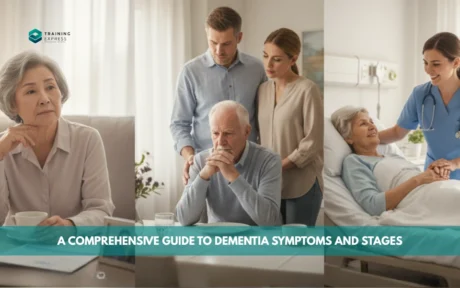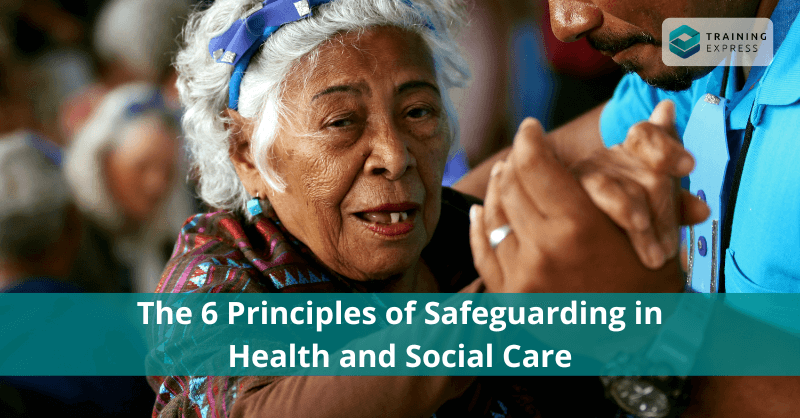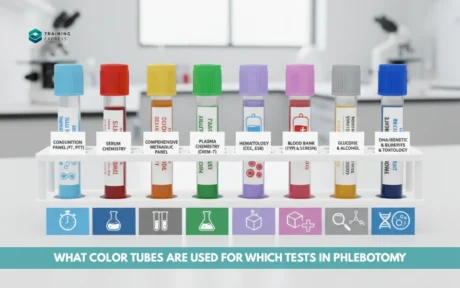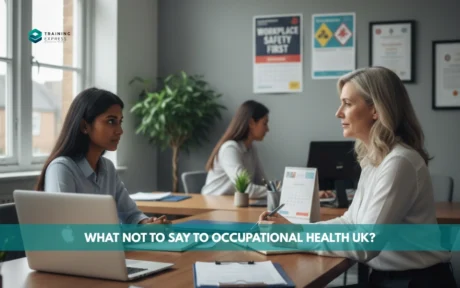

An estimated 541,535 safeguarding concerns were raised during 2021-22, as per NHS publication. This statistic shows just how critical safeguarding in health and social care is.
Picture yourself taking care of a child who is often agitated and acts strangely. But, you are unsure how to make the child feel better or help them. If you learn about safeguarding, you can handle the situation appropriately. This article extensively discusses safeguarding in health and social care to prepare you for such circumstances in your personal or professional life.
Table of Contents
What is Safeguarding?
Safeguarding is the practice of tackling risks associated with vulnerable people. Category of vulnerable people includes –
Vulnerable adults refer to adults with a physical or learning disability, a chronic physical or mental condition, or a decline in physical or mental abilities.
Adult safeguarding is defending an adult person’s right to a safe, neglect- and abuse-free life. And child safeguarding is the process of protecting children from all kinds of abuse, neglect and exploitation.
Everyone has a responsibility for safeguarding in health and social care. In addition, you must take reasonable precautions to mitigate anything that hampers the welfare of the vulnerable. In fact, many welfare concerns may appear. So, it would help if you took appropriate measures to address it.
What is Safeguarding in Health and Social Care?
‘Safeguarding’ is a broad term. Also, different safeguarding incidents could arise in health and social care. For example, a doctor has to follow specific procedures after spotting the symptoms of abuse in a young patient.
Likewise, a social worker may determine how to handle a child’s revelation of abuse. Similarly, a carer can spot a patient’s warning signals of financial exploitation. Let’s look into two circumstances to understand safeguarding in health and social care.

Elderly Care Facility
In an elderly care facility, staffs are responsible for a group of vulnerable adults. Their health, quality of life, and decision-making capacity vary greatly. As a result, carers must know how to protect the people under their supervision.
There are several possible problems. For instance, older relatives may occasionally have their finances exploited in later life. So, staff members must be vigilant and equipped to report suspicions of this kind of abuse.
Children’s Ward in a Hospital
A hospital’s children’s ward aims to provide young patients with excellent treatment. And the medical personnel are responsible for caring for the kids. So, they must be aware of safeguarding issues.
For instance, some parents use violence and physically abuse their children. They might take their children to the hospital and claim the injuries are accidental. Yet, the harm could be intentional. Incidents like this would pose a severe safeguarding problem. Therefore, wards must be safe spaces. And staff members should know who is present and who has access to the kids.

What is a Safeguarding Example in Health and Social Care?
It would be best if you pre-plan about alarming scenarios that might occur in the future. It will help you impose safeguarding in health and social care. Subsequently, make a plan of action in advance. So, you can comprehend how safeguarding in health and social care functions. You can avoid what might happen by thinking about what could happen. Let’s watch how carers respond to an occurrence.
Scenario
Georgia is an older woman who resides in a residential home. For someone her age, she has good mental health. However, she has a few medical afflictions, such as type 2 diabetes and mild dementia. Currently, she needs ongoing care. Nevertheless, she decides to maintain her independence most of the time.

Spotting the Problem
The residential home provides excellent care for Georgia. Besides, the staff members who work with her are watchful and attentive. However, they have noted a rise in Georgia’s unusually high levels of irritation, perplexity, and occasionally fury. Finally, Georgia and one of her carers decide to sit down and talk about what she could be unhappy about.
For example, Georgia frequently feels as though particular friends of hers are dropping by to visit. However, they are requesting money that isn’t returned. In addition, they are reminding her that she’s already pledged to provide money for something, making her feel bad if she forgets. Georgia is generally angry about this and feels cheated.
Empowerment of the Vulnerable People
Give vulnerable people the freedom of choice over how they handle things. It is one of the most crucial components of safeguarding in health and social care. They should feel they have the control to make judgments. For example, the carer in issue informs Georgia that she must document the conversation. Then, she must alert her management. However, Georgia will have the final say in how she’ll handle the situation.
Assessment by Local Authorities
Different local authority structures exist across the nation. A representative expert on adult safety issues invites Georgia to meet. He offers her suggestions on how to handle the problem. This might entail someone approaching the concerned acquaintances. Georgia is receiving the assistance she needs to tackle the matter on her own.
Finalising the Solution
A council employee must represent Georgia’s interests when speaking with the concerned parties. After that, the authority will place a systematic review. It is to ensure that the talks were successful. Georgia has complete control over her funds. Moreover, she doesn’t feel like someone is taking advantage of her. This is how you enable safeguarding in health and social care.

What are the Aims of Safeguarding?
The concept of safeguarding involves concern, safety, and support. The objective is to safeguard the rights of those who are vulnerable. The aims are both reactive and proactive
Protecting Vulnerable People
The main purpose of safeguarding in health and social care is to protect children and vulnerable adults. They require care and protection from danger. So, you must work to lower their risk of facing abuse or neglect.
“Making Safeguarding Personal”
The phrase means protecting people in a way that empowers them to make decisions and exercise self-conscious control.
Rise of Public Awareness
The experts, other staff members, and communities may contribute to avoiding, recognising, and responding to abuse and neglect.
Defined Roles
Safeguarding paves the path to clearly defining the roles and obligations of people and organisations. This helps address safeguarding concerns and keep people safe.

Why is Safeguarding Important?
Safeguarding in health and social care means you must protect children and adults in danger of abuse or neglect. Additionally, you must follow through with safety procedures while working with vulnerable individuals. Without the proper safeguarding regulations, vulnerable people may suffer abuse. Besides, it can have significant repercussions for the organisation.
Therefore, you should establish a system to detect potential abuse and neglect. That will enable safeguarding in health and social care. Specifically, you should remember the following.
- Everybody has the right to go about their daily lives without worrying about mistreatment.
- Vulnerable people deserve the advantage of social comforts and facilities while maintaining safety.
- Consent is the key to successful safeguarding in health and social care.
You have to treat vulnerable people with compassion and empathy. Also, you should be open-minded and recognise that any adult could experience abuse or neglect in any circumstance. Additionally, you should always act in the vulnerable’s best interests. Simultaneously, learn to take immediate action about safeguarding issues.
Everyone must work to prevent harm to vulnerable people and safeguard them. So, you must be alert to any early indications of abuse or neglect. Document any concerns, and report unusual events. If you suspect any criminal activity or immediate risk to an individual, you should call the police by dialling 999.
Safeguarding Children, Young Adults, and Vulnerable People
Safeguarding in health and social care requires you to be analytical and empathetic. Because both Child Safeguarding and Vulnerable Adults Safeguarding are important in health and social care. So, you need to be mindful of them.
There are vital differences in safeguarding different age groups. So, let’s take a look at how people become vulnerable:
- Frequent illness makes people prone to neglect since they cannot care for themselves.
- People with mental disorders are easy targets for manipulation.
- Young people, in particular, lack social awareness. Therefore, it leads them to believe that certain behaviours are acceptable.
- Memory problems in the elderly make them vulnerable to fraud.
What Happens if You Fail to Establish Safeguarding in Health and Social Care?
Lack of proper safeguarding may lead to the following

If you fail to establish safeguarding in health and social care, many things could go wrong. The consequences indicate the need for appropriate and thorough safeguarding procedures in all institutions, including safeguarding in health and social care.
What are the 6 Principles of Safeguarding?
1. Empowerment
It would help if you consistently interacted with vulnerable people. It’ll help you accommodate their requirements. Also, pay attention to their ideas, provide feedback, and value their opinions. Appreciation is important for safeguarding in health and social care. Besides, vulnerable people should believe that they are completely capable of making their own decisions.2. Prevention
To help vulnerable people, you have to pay close attention and assess their situation. For instance, abuse may extend beyond physical ones. Even words and deeds can cause deep, long-lasting wounds.
Carers may fail to offer a vulnerable person the necessary food, clothing, and care. In addition, when people repeatedly reject or rebuke vulnerable individuals, it constitutes emotional abuse.
3. Proportionality
Proportionality means that you consider and address all risks to prevent further harm. The course of action should be proportionate to the degree of danger involved. Hence, a broad overprotective approach can cause more damage if the risk is modest. On the other hand, you need to handle a severe case accordingly.
Reporting cases of abuse or bodily damage can require great courage and work. They should have the impression that you are taking the proper steps. In the absence of that, people could feel disregarded or ignored.
4. Protection
In essence, protection is a crucial aspect of safeguarding practice. You may confuse protection with prevention. Keep in mind that protection is how you handle harm. In contrast, prevention is not letting it happen at all.
Protection is the action to safeguard those at risk of harm or who are already experiencing serious harm. For example, some individuals have already suffered abuse, neglect, or sexual exploitation. For this reason, you need to place concrete measures to handle such harm for safeguarding in health and social care.
5. Partnership
To protect the vulnerable, all organisations and experts must work in partnership. Of course, each individual or organisation will have a different function. Yet, they are all relevant. Besides, they must communicate well. If they don’t, suffering individuals may remain unacknowledged.
Protecting children and vulnerable adults before a crisis occurs falls on the shoulders of the police, health visitors, GPs, hospitals, childcare facilities, daycare centres, schools, after-school programs, and recreation centres. Also, it falls on social workers, family, friends, neighbours, and the local community.
6. Accountability
Delivering safeguarding practices requires complete accountability and openness. Every organisation and individual must be aware of safeguarding. Safeguarding in health and social care requires everyone to work together to fulfil their part.
Here are the six principles when safeguarding children.
Who do the Safeguarding Duties Apply to?
Safeguarding in health and social care includes adults, children, young people, young people in the transition stage, and carers.
Vulnerable adults cannot care for themselves. They cannot defend themselves against lesser harm to severe forms of exploitation.
Adults Who Need Safeguarding in Health and Social Care
There are four key criteria for adults to be defined as vulnerable.
- Adults who need care and support.
- Adults who are being abused or neglected.
- Adults who are in danger of such behaviour.
- Adults with needs who are unable to defend themselves against the possibility of experiencing or witnessing abuse or neglect.
Children and Young People Who Require Safeguarding
The Children Act of 1989 offers the legal framework necessary for organisations to decide on behalf of children. It helps to take action to safeguard children from harm. The adult safeguarding framework includes children and family services that provide leaving or after-care support for young people.
Also, close collaboration with these service providers is essential. It helps determine the best person to guide or support young people through adult safeguarding processes.

Children and young people may be more vulnerable to danger. As a result, they require additional support in households with adults who struggle with –
- mental illness,
- substance abuse,
- violent relationships,
- complex needs,
- or learning challenges.
In addition, the causes and effects of abuse within families might vary depending on the relationships and power dynamics. As a result, professionals across multidisciplinary boundaries have to collaborate to safeguard everyone in vulnerable positions.
Transition
Transition is the period when a child reaches the age of eighteen. When young people turn eighteen, they will likely need adult safeguarding. That’s why safeguarding arrangements are parts of transition support planning and protection.
Authorities have combined the Children and Families Act 2014 and the Care Act 2014. Through this, they developed a complete legislative framework. The Local Authority is responsible for carrying out the obligations under both Acts. However, collaboration amongst all organisations is still necessary for safeguarding in health and social care.
Carers and Safeguarding
While safeguarding in health and social care, a carer may witness abuse or neglect and report it. In addition, carers may suffer unintentional or intentional harm from the adult they are attempting to support. Besides, harm can be caused by the professionals and organisations with which they interact.
On the other hand, a carer may intentionally harm or neglect the adult they are assisting alone or in collaboration with others. It is important to address such issues too.
What Safeguarding Duties does the
Local Authority Have?
Safeguarding is the legal responsibility of local authorities. They commit to advancing community health and well-being. Specifically, the Care Act of 2014 outlines jurisdictional accountability for coordinating care and assistance amongst local authorities and the health sector.
Here are some of the safeguarding duties that local authorities have –
Making Arrangements
An adult who is the focus of a safeguarding enquiry needs to receive the necessary support and representation from an impartial advocate. For that, each local authority will make essential arrangements.

Safeguarding Adult Review
An adult may find it particularly difficult to participate in the process. If there is no other suitable adult to assist them, the Local Authority must undertake a Safeguarding Adult Review.
Adult Safeguarding Team
The Local Authority should work with all its partners to safeguard vulnerable adults. For instance, an adult at risk can be any person 18 years or older in danger of abuse or neglect due to their need for care and support. A safeguarding concern regarding a person who is over 18 but is still receiving children’s services can come up. The adult safeguarding team should handle it without delay.
Enquiry
If the team thinks an adult is facing abuse or is in danger of mistreatment, they must inquire about the situation or make sure others do so. To stop abuse or neglect, the right person needs to take action. Subsequently, they should conduct an enquiry to determine who will be responsible for taking action. After the enquiry and if the local authority is aware of your needs, the following can happen:
- They will not conduct anything new.
- If a carer mistreats or abandons you, the staff will face consequences.
- Someone committed a crime against you. In that case, the local authority will turn over the investigation to the police.
In addition, the authority must establish a Safeguarding Adults Board.
Create Safeguarding Plans
The local authority could create a safeguarding plan that could include the following:
- The actions you should take moving forward. Additionally, further assistance, care, or knowledge you might require.
- Additional risk-prevention measures.
Role of Safeguarding in Health and Social Care
The fields of healthcare and social care overlap most of the time. So, it’s difficult to find a clear distinction between them. Healthcare is generally provided free under the United Kingdom National Health Service (NHS). In contrast, local authorities provide social care.
Understanding certain terms, such as “advocate or safeguarding board”, will help you comprehend the roles of safeguarding in health and social care.
Advocate
An advocate has the expertise to listen to you and speak on your behalf when you need safeguarding in health and social care. It can be challenging to express your opinions or convince others to pay attention to you. In this case, having an advocate can be helpful.
An advocate can help you understand and assert your legal rights. Your local authority must appoint an advocate unless an authorised person is present to help you.
Authorised Person
An authorised person can act on your behalf under the Mental Capacity Act of 2005. Such as
- a deputy
- or someone acting under a personal welfare durable power of attorney,
- or someone who is deemed suitable by a person who is permitted to operate under the Act,
- or, in the absence of a person entitled to act under the Act,
- or, someone whom the local authority deems appropriate.
Safeguarding Board
All local authorities must have a safeguarding adult board. The board carries out safeguarding adult reviews. Besides, they work to assist and protect adults at risk in their local communities. A safeguarding adults board consists of
- the local clinical commissioning group,
- and a senior police officer from the neighbourhood constabulary,
- and the local authority.
Some gatherings may also include invitations to GPs and members of the user, advocacy, or carer groups.

Reasons Local Authorities Believe You Need Care and Support
Here are a few reasons why the local authorities may believe you need support
- You tell them about it. For instance, you’ve contacted your local authority’s adult social services division by phone, email, or letter. You can obtain their contact information from their website.
- Someone else has reported your situation to adult social services. Probably, a person who thinks you need help and assistance.
- You are sent to social services by the hospital or as a result of an investigation into child safety.
The social services department is in charge of determining needs. However, any local authority that suspects you might require safeguarding in health and social care is responsible for assessing you.
For example, the council informed a person named Everett is writing about his unpaid rent. However, Everett’s sister wrote back to the council. She explained that her brother had a mental health issue and had been off work for several months.
In addition, she revealed that he had been struggling to take care of himself and manage his finances. The council’s housing and social services departments are independent of one another. But, the housing department has now learned that he might need care and support. So, the local authorities must assess Everett.
Safeguarding Laws in the UK Health and
Social Care
Laws linked to safeguarding in health and social care are intended to prevent abuse or neglect. In addition, the laws make sure that vulnerable people do not have to worry about their safety. Effective regulations can prevent both legal disputes and personal damage.
The Children Act of 1989
The Children Act (1989) upholds fundamental children’s rights. According to this law, we should
- raise children healthy,
- and assist them in having a lovely time,
- support kids in their efforts to succeed,
- try to make a big difference in children’s lives,
- and work to secure the financial future of children.
Safeguarding plays a crucial role in protecting children’s rights. Children have rights to certain developmental environments. Hence, you must provide them with those environments.
The Children and Social Work Act 2017
The purpose of the Children and Social Work Act of 2017 are as follows –
- Improve decision-making and support for children.
- Improve coordinated work at the local level to safeguard children
- Enable better learning to improve practice in child protection at the local and national levels.
- Facilitate safeguarding of children.
The Care Act 2014
The Care Act 2014 has made significant and meaningful changes to care and assistance. On top of that, it gives patients and their carers autonomy over their support and care.
The Act aims to offer people in need of support more control and influence over how care is provided. And it has altered several aspects of how support is organised. In addition, the Act sets a cap on the amount each person must contribute toward the cost of their care for the first time.
According to the Care Act of 2014, local officials must make arrangements. For instance, the arrangements could be for services, facilities, or resources. It will help avoid, postpone, or lessen the emergence of care and support needs. To compare, the cost of preventative measures is frequently less expensive than the expense of unavoidable future medical demands.
The Safeguarding Vulnerable Groups Act 2006
The Bichard Inquiry (2004) examined the circumstances surrounding the deaths of two children in Soham in 2002. It made recommendations adopted by the authorities, leading to the passage of the Safeguarding Vulnerable Groups Act 2006.
The jobs of workers and volunteers used to afford them extensive access to vulnerable groups. However, the 2006 Act introduces a new vetting and barring mechanism. The Act’s statutory vetting and barring programs cover the health service and social care sectors. Now, people will be better equipped to comprehend their legal obligations.
Summary
Working with vulnerable people is heart-warming and pleasing. However, it involves a multitude of duties. Vulnerable people should enjoy their daily lives instead of facing abuse, fear, or neglect. You may stay with or around vulnerable people. In that case, you must safeguard their security and fundamental human rights.
Safeguarding in health and social care is critical. It ensures the safety of vulnerable people. In addition, it provides a ground for growing empathy and taking responsibility.
It is not possible to maintain a risk-free workplace without safeguarding in health and social care. So, learn more about the 6 principles of safeguarding in health and social care by joining our Safeguarding Vulnerable Adults Training course. You will get adequate knowledge and expertise on safeguarding vulnerable adults and will be equipped to help them lead better lives.
- Available Courses
- Animal care10
- Design28
- Training9
- Accounting & Finance Primary49
- Teaching & Academics Primary37
- Teaching23
- Quality Licence Scheme Endorsed171
- Law10
- IT & Software229
- Job Ready Programme52
- Charity & Non-Profit Courses28
- HR & Leadership4
- Administration & Office Skills4
- Mandatory Training36
- Regulated Courses4
- AI & Data Literacy24
- Health and Social Care290
- Personal Development1621
- Food Hygiene117
- Safeguarding79
- Employability287
- First Aid73
- Business Skills293
- Management425
- Child Psychology40
- Health and Safety528
- Hospitality28
- Electronics31
- Construction62
- Career Bundles201
- Marketing39
- Healthcare172

 Food Hygiene
Food Hygiene Health & Safety
Health & Safety Safeguarding
Safeguarding First Aid
First Aid Business Skills
Business Skills Personal Development
Personal Development





